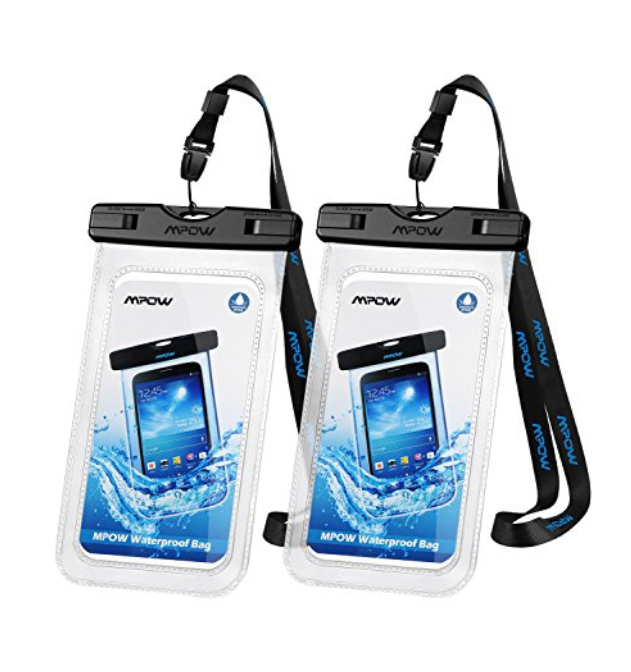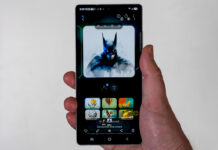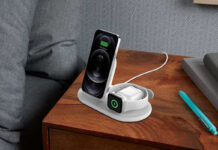 It has happened to the best of us. You have your phone in hand when it accidentally drops into the pool or bathtub. Maybe it’s the toilet (eek!) or perhaps you forgot it outside in the rain. The panic sets in. Don’t fear. Aside from the fact that many of the latest premium smartphones are waterproof or at least water-resistant, there are steps you can take to hopefully minimize the damage, or even outright eliminate it.
It has happened to the best of us. You have your phone in hand when it accidentally drops into the pool or bathtub. Maybe it’s the toilet (eek!) or perhaps you forgot it outside in the rain. The panic sets in. Don’t fear. Aside from the fact that many of the latest premium smartphones are waterproof or at least water-resistant, there are steps you can take to hopefully minimize the damage, or even outright eliminate it.
First, before we delve into what to do if your phone has taken a swim, let’s look at how that might not matter with the latest premium phones.
The latest waterproof phones
![]() If you’re opting for a smartphone from one of the top brands like Apple, Samsung, Google, or Huawei, chances are you’ll notice that they come with a waterproof rating of IP68, which means they can be fully submerged in water as deep as 1.5 metres for as long as 30 minutes. Some phones, like the Apple iPhone 11 Pro and 11 Pro Max, claim they can submerge down to four metres of water for the same duration of time.
If you’re opting for a smartphone from one of the top brands like Apple, Samsung, Google, or Huawei, chances are you’ll notice that they come with a waterproof rating of IP68, which means they can be fully submerged in water as deep as 1.5 metres for as long as 30 minutes. Some phones, like the Apple iPhone 11 Pro and 11 Pro Max, claim they can submerge down to four metres of water for the same duration of time.
Some of the most notable premium phones with a waterproof rating include the Google Pixel 4 XL, iPhone 8, XS, XS Max, and XR, Samsung Galaxy S10, S10e, and Galaxy Note10, Huawei Mate 20 Pro, and Motorola Moto X4.
I wouldn’t recommend leaving your phone to float to test this out. There’s still the risk of damage even if a device is labeled as being “waterproof.” But if you drop it in the pool or want to take some underwater shots, you’ll be fine.
There are also limitations you need to be cognizant of. Water can still seep into “waterproof” phones, especially as they get older. If you plan to use them often underwater or near water, opt for a waterproof case or pouch as an extra layer of protection for your  hefty investment. A waterproof case costing $50-$80 might seem like a big expense, but it’s worth it for a phone that’s probably over $1,000. Plus, in addition to protection against moisture, you’ll also get protection against bumps, dusts, scratches, dirt, and sand.
hefty investment. A waterproof case costing $50-$80 might seem like a big expense, but it’s worth it for a phone that’s probably over $1,000. Plus, in addition to protection against moisture, you’ll also get protection against bumps, dusts, scratches, dirt, and sand.
Note that the waterproof rating of these phones references “freshwater” with low concentrations of dissolved salts and other solids. This means you should heed caution when at the beach or in a pool. Saltwater can be especially dangerous for waterproof phones (not to mention other waterproof gadgets like smartwatches and activity trackers.) Chlorine can also wreak havoc on a device. If your water-resistant phone has any contact with salt or chlorinated water, it’s never a bad idea to rinse it under a sink in clear water and then dry it with a microfibre towel right after. It should remove any salt or sand that way.
You might also want to reconsider taking the device in the shower or bathtub just as an extra safety precaution. But feel free to lay it on the sink counter to listen to tunes while having a bath or shower. Ideally, you’d pair it via Bluetooth with a waterproof portable speaker and use that instead, which will afford better sound than the phone’s speaker anyway!

Consider the waterproof rating as more of a peace-of-mind that if you drop the phone in the pool for a split second or get caught in the rain, it will likely be just fine.
What to do if you drop your phone in water?
If you have an older model phone, or one that isn’t rated for submersion in water, the first order of duty will be to get that moisture out of the device. You’ve probably heard of the old bag of rice trick. It isn’t fake news. It really works. (Yes, I’ve tried it!)
Ideally, you’d catch the phone soon after it has gotten wet. But even if you don’t address the issue immediately, it’s still worth trying to bring the device back to life or maintain its operability, even if just long enough to get your data. I once saw an old BlackBerry come back to life using the rice trick after it had sat out on a patio in the rain for hours!
In any case, the first thing you should do is power the device off, remove the battery (if it has a removable battery), remove the SIM card and any other card media (e.g. a microSD card). Remember, the last thing you want to do is run power to an electrical device that’s wet. Try to dry it out manually if you can using a soft dishtowel. But if you feel that moisture might have snuck into the nooks and crevices, move on to the next step.
- Grab your biggest bag of rice.
- Push the phone down into the middle and cover it completely under the rice.
- Seal the bag.
- Wait at least 24 hours, or up to three days if you think the phone has gotten totally wet.
Just as rice sucks moisture out of water or broth when you’re cooking it, the rice will slowly but surely suck the moisture out of the phone until it’s (hopefully) bone dry. If you want to try and speed up the process, leave it out in the sun.

After the 24-hour period and lots of finger tapping and anxious fiddling, take the phone out. Re-insert the battery (or a new one if you feel the other one might have been damaged/corroded from the water), hit the power button, cross your fingers, and wait. If it boots up, you might be in luck!
In addition to using your household supply of rice, there are actually emergency kits you can buy to keep on hand to use in the event that a smartphone takes a dive. They usually include a moisture-absorbing bag that contains silica, which can remove moisture. Some include a reusable drying disc and bag, while others are designed for one-time use.
If there are still issues, or you notice issues after a few days, contact the manufacturer or retailer if you have a warranty that covers water damage (some companies and retailers let you pay extra to cover at least one instance of accidental water damage) or take it to a third-party repair shop. It will cost you to have it fixed but it still might be cheaper than buying a new phone.
 Waterproof phone accessories
Waterproof phone accessories
If you want to ensure some added protection, even for phones that are rated as waterproof, to safely take underwater pics in the pool or at the beach, place the phone inside a waterproof case for peace-of-mind. The phone might be fine without it, by why take the risk?
I actually prefer waterproof pouches to cases because it’s easier to take your phone out and put it back in repeatedly to switch back and forth multiple times a day. For example, I’ll keep my phone in the pouch (I use these Mpow ones) while hanging out at the pool or on the beach at a resort but take it out when we head to lunch. Many of these come with lanyards so you can wear the phone around your neck or crossbody; ideal for the beach, on a resort, or while out and about at a waterpark.
Be prepared so you don’t have to worry
It isn’t the end of the world if you drop your phone in the water. As noted, many of the latest premium phones are waterproof, or at least water-resistant, which means a quick dip in the pool is no sweat and they’ll continue to function fine.
But given the fact that the waterproof rating relates to freshwater, there is always a small risk of water seeping in where it shouldn’t. These phones cost a pretty penny, so you’re better off to still invest in a waterproof case or pouch if you want to take the phone to the beach or waterpark.
If an accident does happen, though, you can protect your phone to ensure that it continues to work just fine using this handy trick that requires nothing but a common household pantry item and plenty of patience.
Check out a selection of smartphones, including waterproof ones, as well as waterproof cases and pouches, at Best Buy Online.




And if you have a Z3… don’t worry about it!
http://www.bestbuy.ca/en-CA/product/sony-bell-sony-xperia-z3-16gb-black-2-year-agreement-ls5803br/10327538.aspx
Silica gel packets (those little packets you usually see in shoeboxes and bags of jerky) work a lot better than rice does for removing water. They are specifically designed to remove moisture. Once used you need to get the moisture out of them, but a quick Google search would explain how to do that. I realize that you mentioned these in your post, just wanted to expand a bit because they are awesome.
Also, many phones these days don’t have removable batteries. I wouldn’t advise prying your phone open to get the battery out unless you really know what you’re doing and you’re outside your warranty period.
JB
Remember that, your refrigirator like your Air Conditioner, is considered a “dehumidifier”, and might work a bit better and faster than wrapping your phone in rice or silica gel packs.
just don’t put it into a freezer for rapid results….. water expands when frozen.
Comments are closed.